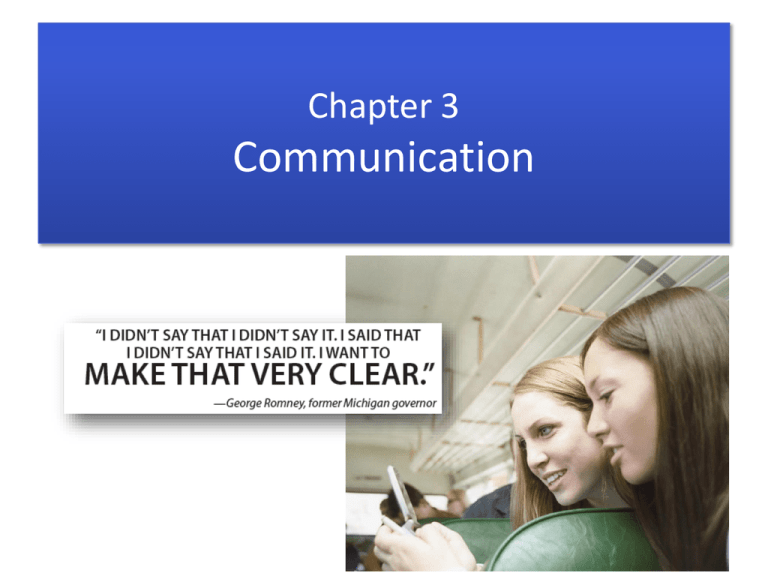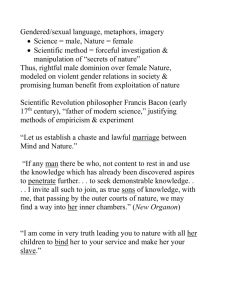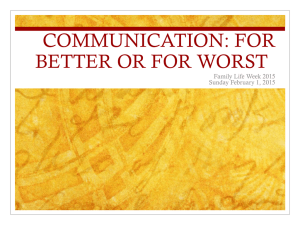chapter 3 - MDC Faculty Home Pages
advertisement

Chapter 3 Communication Chapter Sections • 3-1 The Nature of Interpersonal Communication • 3-2 Conflicts in Relationships • 3-3 Principles and Techniques of Effective Communication • 3-4 Self-Disclosure, Lying, Secrets, and Cheating • 3-5 Gender Differences in Communication • 3-6 Theories Applied to Relationship Communication • 3-7 Fighting Fair: Seven Steps in Conflict Resolution Conflict • When you hear the word “conflict,” what comes to mind? • What thoughts, images, or feelings do you associate with the word “conflict”? Conflicts Conflict: the process of interaction that results when the behavior of one person interferes with the behavior of another Conflict • Conflict is inevitable. • Conflict can be beneficial. Nature of Communication • Communication is both verbal and nonverbal. • Nonverbal communication uses gestures, eye contact, body posture, tone, volume, and rapidity of speech • We assign more importance to nonverbal than to verbal cues. • Texting is becoming an important way to communicate. Conflict • What are some sources of Conflict in relationships? • Behavior • Cognitions and perceptions • Value differences • Inconsistent rules • Leadership ambiguity Conflicts Styles of Conflict • • • • • • Competing—both try to get their way Collaborating—both express their views and compete Compromising—both find middle ground Avoiding—both avoid confrontation Accommodating—each attempts to soothe the other Parallel—both deny, ignore, and retreat Self-Disclosure, Lying, Secrets, and Cheating Self-Disclosure: • Necessary for development of relationships • Encourages disclosure • Depends on the relationship Self-Disclosure, Lying, Secrets, and Cheating Secrets: – Most keep some secrets from intimate partner. – Females keep more secrets. – Spouses keep more secrets than dating partners. – Blacks keeps more secrets. – Homosexuals keep more secrets. *See page 59 Self-Disclosure, Lying, Secrets, and Cheating Cheating: • A significant amount of cheating occurs in relationships. • Cheating may be either or both sexual and nonsexual. • Intercourse? • Masturbation? • Flirting? • Sexting? • Fantasies? Gender Differences in Communication • Women seek to preserve intimacy and avoid isolation. • Men seek to win. Gender Differences • Women tend to react more emotionally. • Mothers use more affiliative (relationship) speech. • Women disclose more than men. • Both value openness, honesty, respect, humor, and resolution. Theories Applied to Relationship Communication Symbolic Interactionism • examines the process of communication • considers importance of definition of situation • sees taking the role of the other as important to conflict resolution Theories Social Exchange Theory • considers importance of rewards and costs • sees importance of acknowledgement, legitimacy, and respect Fighting Fair: Seven Steps in Conflict Resolution • Developing and using skills for fair fighting and conflict resolution are critical for the maintenance of a good relationship. • Resolve conflict in a way that will leave the partners and their relationship undamaged. Fighting Fair 1. Address recurring, disturbing issues. – Ensure privacy, sufficient time, and lack of unrelated stress. 2. Identify new desired behaviors. 3. Identify perceptions to change. 4. Summarize your partner’s perspective. Fighting Fair 5. Generate alternative win-win solutions. – Brain-storming: suggesting as many alternatives as possible without evaluating them – Win-win relationships: conflict is resolved so that each partner derives benefits – Win-lose solution: one partner gets nothing and one partner gets everything – Lose-lose solution: both partners get nothing Fighting Fair 6. Forgive 7. Be alert to defense mechanisms – Unconscious techniques that function to protect individuals from anxiety and to minimize emotional hurt Fighting Fair Defense Mechanisms • Escapism: simultaneous denial and withdrawal from a problem • Rationalization: cognitive justification for one’s own behavior that unconsciously conceals one’s true motives • Projection: unconsciously attributing individual feelings, attitudes, or desires to the partner • Displacement: shifting your feelings, thoughts and behaviors from the person who evokes them onto someone else





